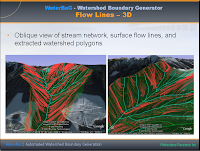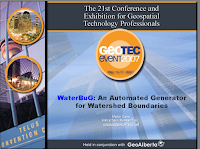No question, GE has been wildly succesful. It pretty much single-handedly created the category of "spinny-globe" applications. As usual for Google, it redefined the parameters of what people thought the web was capable of doing (never mind that it was really Keyhole that did this, and skipping lightly over the fact that Google had to release a thick client app to achieve it). The bottom line is that GE has huge mindshare that competitors (WorldWind, MS Virtual Earth, ESRI ArcExplorer) are only just starting to nibble away at.
But can it last?
My prediction (and hope) is - No. Or at least, not in the same category-dominating way.
Reasons?
One is that the spinny globe paradigm is simply too fundamental to the way we want to interact with the virtual world to be left to a single company or application to dominate. Google/Keyhole proved the concept, but WorldWind shows that it can be done more generally and more openly - which in the end I believe has to win out.
Another is that as I've worked a bit more with GE and KML, I am astounded and annoyed by the numerous limitations of the data visualization options they provide. The simplest GIS viewer provides way better visualization options than GE (I know - I wrote
one!). This isn't rocket science. My guess is that this reflects the fact that Google is not in the business of providing great visualization - they're in the business of selling ads. Which brings me to my next point...
It is probably contrary to Google's business model to enhance GE's capabilities too far. Make it more powerful and more configurable, and people start using it to do things which are just a distraction to the business of getting eyeballs on ads.
One possible opposing force to this thesis is the rising competition with other SG vendors (most notably of course MS). Perhaps this competition will force the evolution of greater functionality. But I'm not holding my breath - the other vendors all have their own business models which probably don't encourage loading functionality into the tools. The vendor with the most to gain from providing full-spectrum functionality is ESRI - but since they're really in the business of selling software, not data, my guess is that whatever they come up with is not going to be a real happy place to be for many users.
The one great hope IMO is WorldWind. They are ahead in some ways, behind in others, but they alone have no agenda other than making a really great SG application. I only hope they continue to thrive - although their dependence on the bureacratic whims of NASA makes me worry.
To go way out on a limb and look 20 yrs down the road, it may well be that spinny-globe access becomes much like topographic maps today - so essential to individual and business information that they (or at least the data repositories and protocols) are government-sponsored and freely available to all (ok, so topo maps aren't currently 100% free, but even here in behind-the-curve Canada more and more spatial data is being made freely available by Gov't). Maybe the SG app will just become a standard view in whatever is being used as a Web browser, with open formats and data models.
We can only hope...









